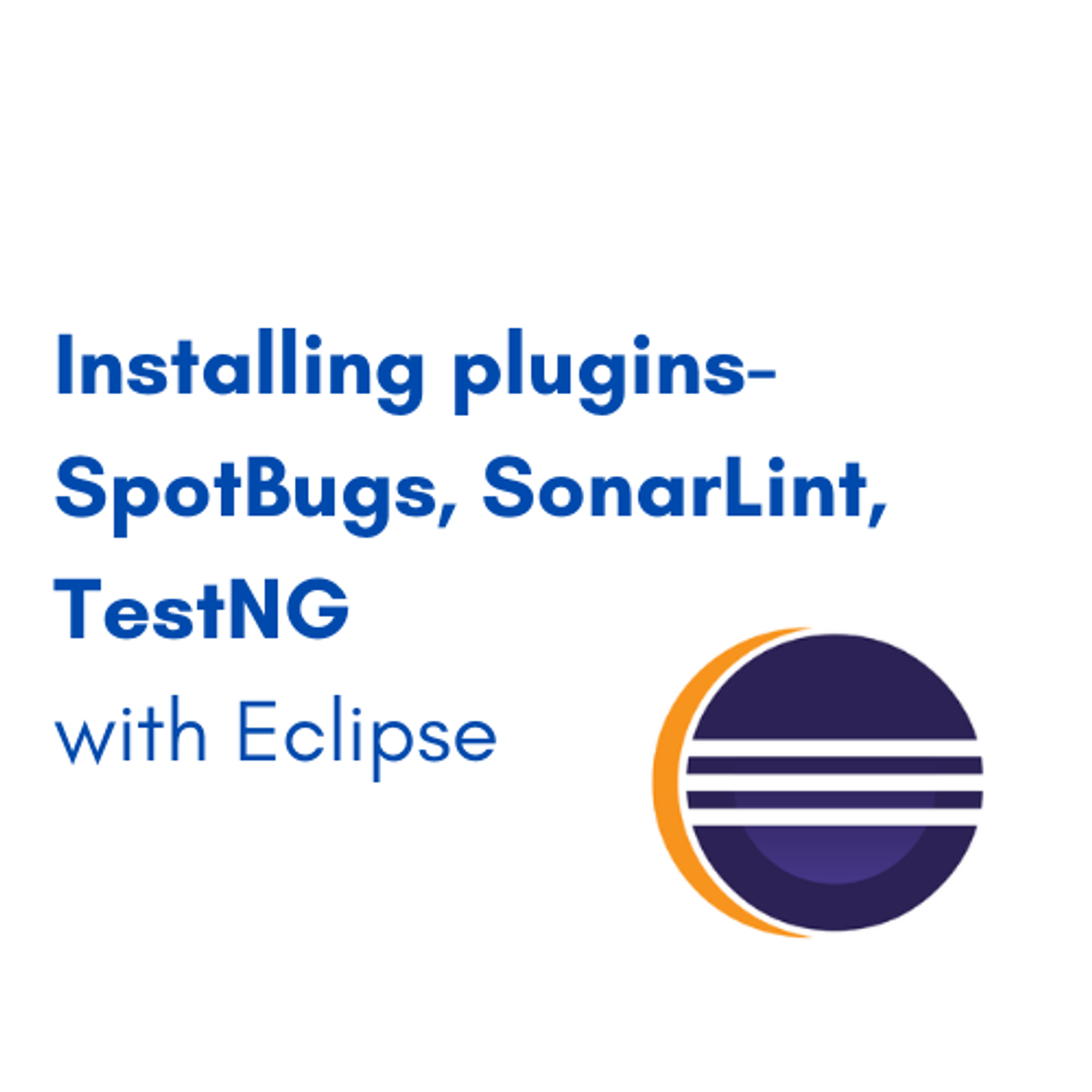Back to Courses









Computer Science Courses - Page 82
Showing results 811-820 of 2309

Installing Plugins- SpotBugs, SonarLint, TestNG with Eclipse
By the end of this project, you will be able to install and configure SpotBugs, SonarLint and TestNG with Eclipse.
Throughout the project, You will be able to identify plugins and use them.
Moreover, you will use Eclipse’s Marketplace which is such a versatile and important tool for any aspiring Java developer that will be using Eclipse in his line of work.
This guided project is for beginners. The prerequisites needed is to have basic programming knowledge and to have touched base with a coding environment before to be able to understand the various terminologies that I will be mentioning throughout this guided project. It is dedicated to those interested in using Eclipses’s marketplace to install plugins. In particular, we will focus on SpotBugs, SonarLint and TestNG. These specific plugins will ease the coding process of any aspiring Java developer. The quality of your code will drastically increase. Eclipse is considered one of the most popular and most powerful IDEs, it’s widely used by many companies around the world.

Build Responsive Image Gallery UI using CSS3 Flexbox
This project will teach you how to implement and build Image Gallery UI using CSS3 Flexbox. This project also teaches the different Flexbox playground options and also the differences between the Flexbox and the CSS Grid are mentioned so that one decide on which layout to choose for building modern web layouts.
Note: This course works best for learners who are based in the North America region. We’re currently working on providing the same experience in other regions.

Gain Actionable Feedback with a 4Ls Retrospective in Miro
By the end of this project, you will be able to lead and document a 4 Ls project retrospective to explore lessons learned while focusing on actions and improvements.
To do this, you will gain hands-on experience working in the Miro online visual collaboration platform for teamwork while you build trust, improve morale, and increase engagement during a project retrospective.
Note: This course works best for learners who are based in the North America region. We’re currently working on providing the same experience in other regions.

Practical Use Cases of CSS3 Flexbox
By the end of this project, you will understand some of the practical use cases of Flexbox in easy way which can be helpfull in building modern web layouts. And you will also understand the differences between Flexbox and CSS Grid so that one can decide at very early stage of the web development UI process which one to choose.
Note: This course works best for learners who are based in the North America region. We’re currently working on providing the same experience in other regions.

Protecting Cloud Architecture with Alibaba Cloud
Course Description
The Security Exam Preparation Course is a series of online courses covering topics including Linux and Windows OS basics and operations, network fundamentals, host security, application security, network security, and data security. It is designed to help you understand how these products work, how they should be used, and help you gain the required knowledge to prepare for the ACA/ACP level cloud security specialist.
To earn an official Alibaba Cloud certificate please join the Security courses on the Academy's website:
Cloud Platform Security Overview: https://edu.alibabacloud.com/certification/clouder_securityoverview
Secure Your Data on Alibaba Cloud: https://edu.alibabacloud.com/certification/clouder_securedata
Use Alibaba Cloud Anti-DDoS Service to Defend DoS Attack: https://edu.alibabacloud.com/certification/clouder_ddos

Artificial Intelligence Data Fairness and Bias
In this course, we will explore fundamental issues of fairness and bias in machine learning. As predictive models begin making important decisions, from college admission to loan decisions, it becomes paramount to keep models from making unfair predictions. From human bias to dataset awareness, we will explore many aspects of building more ethical models.

Cloud Computing Applications, Part 2: Big Data and Applications in the Cloud
Welcome to the Cloud Computing Applications course, the second part of a two-course series designed to give you a comprehensive view on the world of Cloud Computing and Big Data!
In this second course we continue Cloud Computing Applications by exploring how the Cloud opens up data analytics of huge volumes of data that are static or streamed at high velocity and represent an enormous variety of information. Cloud applications and data analytics represent a disruptive change in the ways that society is informed by, and uses information. We start the first week by introducing some major systems for data analysis including Spark and the major frameworks and distributions of analytics applications including Hortonworks, Cloudera, and MapR. By the middle of week one we introduce the HDFS distributed and robust file system that is used in many applications like Hadoop and finish week one by exploring the powerful MapReduce programming model and how distributed operating systems like YARN and Mesos support a flexible and scalable environment for Big Data analytics. In week two, our course introduces large scale data storage and the difficulties and problems of consensus in enormous stores that use quantities of processors, memories and disks. We discuss eventual consistency, ACID, and BASE and the consensus algorithms used in data centers including Paxos and Zookeeper. Our course presents Distributed Key-Value Stores and in memory databases like Redis used in data centers for performance. Next we present NOSQL Databases. We visit HBase, the scalable, low latency database that supports database operations in applications that use Hadoop. Then again we show how Spark SQL can program SQL queries on huge data. We finish up week two with a presentation on Distributed Publish/Subscribe systems using Kafka, a distributed log messaging system that is finding wide use in connecting Big Data and streaming applications together to form complex systems. Week three moves to fast data real-time streaming and introduces Storm technology that is used widely in industries such as Yahoo. We continue with Spark Streaming, Lambda and Kappa architectures, and a presentation of the Streaming Ecosystem. Week four focuses on Graph Processing, Machine Learning, and Deep Learning. We introduce the ideas of graph processing and present Pregel, Giraph, and Spark GraphX. Then we move to machine learning with examples from Mahout and Spark. Kmeans, Naive Bayes, and fpm are given as examples. Spark ML and Mllib continue the theme of programmability and application construction. The last topic we cover in week four introduces Deep Learning technologies including Theano, Tensor Flow, CNTK, MXnet, and Caffe on Spark.

Getting Started with Cascading Style Sheet
In this 1.5-hour long project-based course, you will gain hands-on experience with one of the most fundamental skills for a web developer: CSS, cascading style sheet. You will transform a very plain website to a beautifully presented one in this project! If you have some basic knowledge of HTML but found CSS perplexing, or just want to hone your CSS skill, this course is for you!
By the end of this course You will understand how CSS works, have a basic understanding of the essential topics, and be able to apply it to web development and web design projects!

Build File Utilities with Linux Shell Script
In this 1.5 hour guided project, you will learn about the Linux file system. How to manipulate files in Linux as well as using shell script to build useful utilities. At the end of this project, you will have built 3 useful file utility shell scripts (5 if you participate in the optional practice and cumulative challenge).

Introduction to iOS Mobile Application Development
Learn about iOS development by learning about the OS and the development platform. Discover how to set up and prepare a local environment. Get acquainted with the Swift playground and write code in Swift.
By the end of this course, you’ll be able to:
-Demonstrate a working knowledge of the general principles of mobile apps and the iOS ecosystem
-Set up and explore the XCode environment
-Demonstrate an understanding of how XCode is used in the Swift app development process
-Write Swift code and create UI with the use of Swift playgrounds
-Navigate the Swift UI
-Manipulate data in Swift
You’ll gain experience with the following tools and software:
-Swift application and software
-iOS software and development environment
-Mobile OS
-XCode
-Objective-C
-UI frameworks
-Testflight
-UI storyboard
-MVC
-APIs
